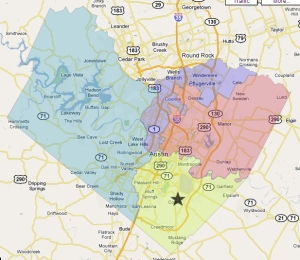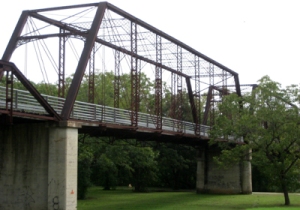Onion Creek
Monday, January 4th, 2010 in explore Travis County, places. 1 Comment
In some ways, the Onion Creek area has not changed much from the time of its settlement in the mid-1800s. Situated in southeastern Travis County, this rural area remains primarily agricultural in nature, with open pastureland and wooded, gently rolling hills. In stark contrast to the nearby bustling metropolis of Austin, many of the original open fields remain to this day, providing a unique glimpse into the area’s past.
Up until the 1840s, most of the lower Onion Creek area remained virtually unexplored by nonnative peoples. The earliest settlers were farmers, who cleared the land to grow cotton and corn on the fertile soils, and whose livestock grazed the land. Even after those first pioneers established their farms, the land remained only sparsely populated. Just a few solitary structures, such as cabins, mills and barns, dotted the landscape, and wagon ruts, few and far between, served as rudimentary roads. The area was considered by many to be too dangerous to inhabit, and those who did choose to settle had to protect themselves against Indian raids.
Continued lack of quality roads reinforced the pattern of dispersed, isolated farmsteads. By 1890, however, the population of southeastern Travis County had grown large enough to support a few small community clusters. Moore’s Crossing, one such community, was established on a low water ford of Onion Creek. By the end of the nineteenth century, it included a small number of one-story wood-frame buildings, most notably a general store, where the local farmers gathered to purchase supplies and talk crops.

Courtesy of C. Michalk
While farm work was the primary livelihood for nearly all in the area, community life focused around the activities of church and school, for which Onion Creek provided the backdrop. Members of the local Black Baptist churches used Onion Creek as a gathering place for services and week-long revivals, and baptisms were performed in the cool water of the Creek.
Families, too, enjoyed the tranquility offered by Onion Creek. They fished in its waters and held picnics along the banks, under the cool shade of the tall pecan trees. Yet, Onion Creek was not always so peaceful. Being located in a flood plain, the area was apt to flooding, and some of the more severe floods over the years washed away bridges, homes, and in the 1920s, even an entire family.
As the years have progressed, the city of Austin has grown, expanded and developed, inevitably changing the physical character of the Onion Creek area. Paved roads and highways, modern housing developments, and commercial enterprises have begun to cover much of the formerly pastoral landscape, and the majority of families in the area no longer live on traditional farms. For the most part, however, the rural nature of the Onion Creek area remains intact. Large tracts of open land and even several buildings remain as tangible links to the area’s 19th and early 20th century history.
For more information on the Onion Creek area, the Archives has recorded several oral histories of past and present residents of the area.



Good morning. This excellent article mentions some oral histories of the Onion Creek area, but when I click that link, I get a page broken message. Can you let me know what oral histories are available from the Onion Creek area?
Thanks.